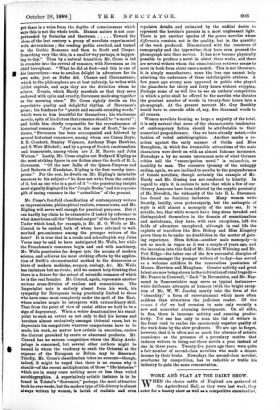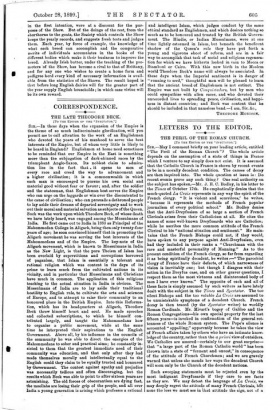WORK AND PLAY AT THE DAIRY SHOW.
WHEN the choice cattle of England are gathered at the Agricultural Hall, as they were last week, the.y enter for a beauty show as well as a competitive examination.
There are prizes for looks as well as for performance, and part of the excitement of the week is to see how far the awards agree.
The result generally confirms the belief that beauty and goodness are one. But the former takes advantage of all the aids to victory. Each of the competitors has her personal attendant, and many of them complete sets of toilet apparatus and cosmetics. To the stranger it is perhaps a little sur- prising to see by the side of a little golden-coated cow a large chest, on which is painted in white letters "Her Grace the Duchess of —." This is not the name of the cow, but of her young and beautiful owner, who will probably pay her a visit during the first day of the Show to see that she is comfortable and not in a draught, or too near the door. In that chest is the " dressing-case " and equipment intended to efface the marks of travel and to enhance the beauty of the candidate during her stay at the Show.
First her horns are attended to. This is an important matter ; quite as important as coiffure. In the box is a packet of emery-paper for smoothing the horns, and a flask of very special oil for polishing them. When the crescent on her brow glistens like the new moon the comb and brushes are taken out and her coat receives attention. Then she is rubbed down with a patent cloth, and if she needs a tonic after her fatigue a little medicine chest is ready, filled with specifics for all ailments. Besides these there are outdoor and indoor slothes in the box, both rugs and coats, and if the occasion is an "outdoor show" neatly made tarpaulins, all duly marked with the proprietor's name, are fitted up as screens to keep off rain or wind. There is also literature in the boxes,— " notices " of the cow's performances at shows, and catalogues of sales held at her proprietor's home-farm in which her ancestors or offspring have made high prices and won a name for themselves. These are offered, with an intuition born of long practice, not to the mere gazer, but to sympathetic persons who are genuinely interested and betray some knowledge of the mysteries and history of pedigree herds. It is no wonder that with all this personal attention and with the benefit of their attendants' society all day long the gentle cattle, from the dark-red Suffolk to the tiny Kerry cows, become as tame as it is possible for them to be. Otherwise they might suffer from "nerves," and not give their maximum yield of milk.
To see them at their meals is a pleasant sight. "The Hall" supplies hay of the sweetest, and straw for beds. But hay is only the ground floor, as it were, on which success is built. It belongs to the sentimental or golden age, before the constituents of milk were known. Now, if it were considered useful, they might have asparagus, or French beans, and though neither are recommended, their fare is as varied as it is obviously delightful. What it is exactly depends on whether they are entering for milk prizes, or for butter com- petitions. Pleasant" it is to see a really deserving little cow, with the weight of her morning's yield posted proudly in front of her, enjoying her afternoon tea before milking time. She has her choice of pease meal, or bean meal, or crushed oats, with a mouthful of bay between, when she likes, or a piece of "cake" or a slice of carrot. Then her groom may be seen with a trayful of the hearts of elegant little cabbages out neatly into fours, tempting her to have "just another mouthful," a request which, to do her justice, she generally grants. The Jersey cows are specially fed with parsnips, that bounteous root whose merits as food for the dairy the ingeni- ous Channel Islanders found out long before any one else did, and long maintained the secret, under a specious pretext that they grew their parsnips to sweeten—we will not say adul- terate—their cider.
At the approach of milking-time the attendants grow anxious, and the cattle even more serene. The men stroke and talk to their cows, smoothing their backs nervously, and handling their pails, while dairymaids, numerous as the daughters of Dana, enter the circle in the centre of the hall, to churn the last night's milk into butter. Then a bell rings, and the Agricultural Hall instantly becomes the largest milking- shed in the world. Two hundred cows are being milked into as many pails by two hundred anxious cowmen. Two-and- twenty dairymaids are churning as persuasively as it is possible to churn milk into butter, and anxious friends and relatives of the dairymaids and of the milkers, or admirers Of
their particular animal or herd, stand by in hushed atten• tion. It is a solemn moment. People who are connoisseurs in the ways of churns pay fees to sit opposite the particular dairymaid whose skill they fancy, and guess by eye what the weight of the butter is when it is made, while the supporters
of particular cows which are being milked, after the last drop has trickled into the pail, follow that pail to the weighing-room, and then rush back in triumph to see the weight written up under the figures of the morning's yield. Then the tension is relaxed, and the merits of 'Golden Lad's' descendants or the peculiar virtues of ` Dig- tinction's Pride' (who, if names go for anything, ought to be something very wonderful indeed) are once more canvassed by those who are knowing in that line, and have learnt the herd- book off by heart. As usual the little Channel Island cows had things all their own way in the matter of butter-producing. These small and graceful creatures, with heads more beautiful than those of deer and the light, active frames of souse wild animal, give more butter than a big shorthorn twice their size. Of the first eleven winners of a special prize for cattle of all breeds ten were Jerseys, including the four placed first. Size is almost discounted in these competitions, and there is a gradual approach to one of the ideals of the breeiers of domesticated animals, that of creating a single breed which will take the place of all others for a particular purpose. The astonishing productiveness of the Jersey cattle, the beauty of their colour, their small size, sweet temper, and good con- stitutions, have properly won for them the highest place among the dairy animals of the world. That this highly developed and valuable breed should have been first produced by the skill of one small island community in the English Channel is among the curiosities of animal life. Even now the English herds need to be constantly replenished with others from "the island," and rows of little imported heifers always attend the Dairy Show. The red Devons seem to flourish best on their own red soil, and were not in evidence at the Show. But all the other famous cattle of this country, Ireland, and Scotland were competing. Each year shows the value of what is known as "pedigree" in cattle. Every one has beard that when every variety of fowl had been brought to perfection in their respective kinds, it was found that after all there was nothing so good as a "barn-door hen," a mixture of all kinds. But experience shows that there is no such thing as a "barn-door cow" worth keeping. Whatever it is it must be of a special breed and pure, and though the first crosses of pure breeds are often excellent, none further removed than this from the true blood are allowed to compete in the Show. Of the other famous dairy animals there are Ayrshires, the dairy cows of Scotland ; short- horns, the "general purposes" cattle, looking as against the Jerseys like elephants by antelopes ; and the beautiful dark. red hornless cattle of East Anglia, now rapidly rivalling all the larger breeds ; Guernseys, yellow and white Channel Islanders, less beautiful than the Jerseys ; and little black Kerry cows, active and impudent. Ingenious owners have developed from these a toy cow, black or red, known as the dexter Kerry. It is our counterpart to the dwarf Indian cattle, resembling our heavy breeds in shape, but often no larger than a Shetland pony. The dexter Kerrys give wonderful yields of milk, are content with rough food, and make handy and picturesque dwarf herds for the paddocks of the small country home.
Nor is the goat, "the poor man's cow," omitted in the place of honour at Islington. Goats are there of all sizes and colours, as tame as pet dogs, and almost as various in shape and colour, treated all day to presents of apples and biscuits, and more at home in the crowd of a London show than any cattle. Mr. Bryan Hook, Sir Humphry de Trafford, and Lady Burdett-Coutts are among the pioneers of the improvements of this ancient race. Those who remember what poor rough creatures English goats were twenty years ago would scarcely believe that these sleek, silky-eared, and productive animals were of the same species. Many are rich black-and-tan, with falling ears and no horns. Others have curving horns like the wild ibex, and thick, mealy coloured coats, like the goats of Angora. There were real Angoras, with a fleece as fine as those bred in Asia Minor, or the still more valuable exported herds at the Cape, though these, not being dairy animals
in the first intention, were at a discount for the pur- poses of the Show. But of the doings of the rest, from the shorthorns to the goats, the Soaiety which controls the Show keeps the yearly records, and suggests fresh tests and judges them. Each year, by force of example, the knowledge of what each breed can accomplish and the comparative merits of individuals accumulates in the books of the different bodies which make it their business to improve the breed. Already Irish butter, under the teaching of the pro- moters of the Show, has become a rival to that of Brittany, and for any one who wishes to create a home farm and pedigree herd every kind of necessary information is avail- able from the statistics of the Shows. The result hoped is that before long English dairies will for the greater part of the year supply English households ; in which case virtue will be its own reward.








































 Previous page
Previous page